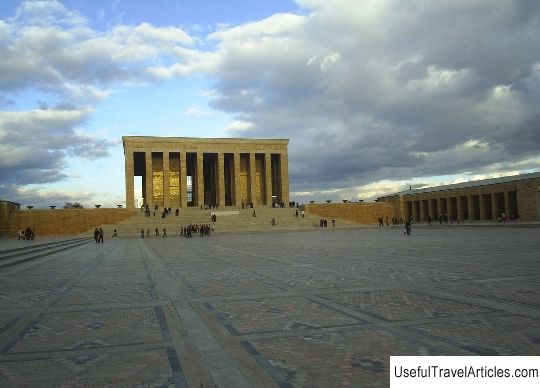Mausoleum of Ataturk (Anitkabir) description and photos - Turkey: Ankara
Rating: 7,5/10 (100 votes) 
Mausoleum of Ataturk (Anitkabir) description and photos - Turkey: Ankara. Detailed information about the attraction. Description, photographs and a map showing the nearest significant objects. The title in English is Anitkabir. Photo and descriptionA very important historical and cultural complex in the capital of Turkey Ankara is the mausoleum of Mustafa Kemal, the founder and first president of the Turkish Republic. Another name of the mausoleum is Anitkabir, which translated from Turkish means “mausoleum, burial vault”. For a huge contribution to the creation of modern Turkey and the development of the national identity of the Turks, the people of Kemal are called Ataturk, which means "the father of the Turks." During his fifteen years of reign, the Turkish people have practically reached Western standards of living and made a big leap forward. Ataturk built schools in every city and every village, changed the Arabic alphabet in Turkish to Latin, which is more accessible and familiar to most other peoples. Mustafa separated religion from state relations and began to reform Turkish laws, adjusting them to modern international standards. During the period of his reign, women received equal rights with men, a modern economic system was formed in the state and the existence of surnames was officially recognized. Mustafa Kemal selflessly served his people and achieved the revival of the nation, for which he received universal respect and was even awarded the construction of a mausoleum. Ataturk died on November 10, 1938, having lived for more than 56 years. The solemn ceremony of laying the first stone in the foundations of the mausoleum took place six years later, in October 1944, and the construction of the complex was completed in 1953. Before the construction began, a competition was announced for the best project, in which 27 foreign and 20 Turkish architects. The winners of the competition are Turkish architects Emin Khalid Onaton and Ahmed Orhan Arda. During construction, their project underwent minor changes that arose due to financial difficulties. The project provided for two floors, but only one was built, fortunately this did not affect the grandeur of the building at all. The total area of the complex is 750 thousand square meters. This includes the mausoleum itself, a park, a museum and other buildings. An observation station was previously located on the site of the mausoleum, and at the top of the hill there were burials that belonged to the ancient state of Friga, founded at the beginning of the 12th century. When the decision to build the mausoleum was made, the territory had to be freed from burials and archaeological excavations had to be organized. Carrying out these works presented the Museum of Anatolian Civilizations, where the household items of Frig's inhabitants are now located, a large number of priceless historical finds. The majestic complex of the mausoleum was built in the style of the ancient Anatolian and Hittite eras, it combines both ancient and and modern architectural features. Most of the interior decoration is made of marble and tuff, which were brought from different parts of Turkey. The decoration of the columns of the mausoleum and the sculptures of lions was made with white limestone tuff brought from the Pynarbashi county of the Kayseri region. The plaque on the sides was faced with white marble brought from the Afyon region. For the decoration of the ceremonial square, red and black travertine was used, brought from the Kayseri region, more precisely, from the village of Bogazkopru. Yellow travertine was brought from the village of Eskipazar in the Cankiri region, which was used to decorate the columns of the ceremonial square. The construction of the Ataturk Mausoleum complex consists of three parts: the central alley with lions, the ceremonial square and the mausoleum itself. There are ten symmetrically placed towers in the building of the mausoleum, each of them symbolizes the most important ideas of Mustafa Kemal, which influenced the development of the Turkish state. On the roofs of the towers there are bronze Turkish spears - in ancient times, such spears were installed on the tops of tents. Ataturk's sayings are inscribed on the inner walls of the towers. In the very center of the ceremonial room, there is an oratory decorated with quotes from the works of Ataturk. The body of the father of the Turks himself is located in the lower part of the mausoleum, a tomb, under a symbolic plaque in the hall of honor. In special vessels located around the tomb, there is earth brought from different regions of the country. The Ataturk Museum, which contains his library and personal belongings, is located near the Mausoleum. You can see the cars that Mustafa Kemal drove on the square in front of the museum. The building of the mausoleum rises above the delightful Baris Park, where tree seedlings were brought from all regions of Turkey and around the world, such as Greece, Yugoslavia, Portugal , Afghanistan, Norway, USA, Egypt, Cyprus, Canada, Japan, Italy, Germany, Sweden, Austria, Spain, Belgium, France, Denmark, Finland, Great Britain, China, India, Iraq, Israel. The number of trees that grow in this park currently reaches 48,500 thousand, among them there are more than a hundred different types of plants. Every year the complex is visited by millions of visitors and every year their number is growing. Ankara boasts many interesting historical monuments, but among the modern buildings, Ataturk's mausoleum can be called one of the most important.       We also recommend reading St Michael's Hill (Glastonbury Tor) description and photos - Great Britain: Glastonbury Topic: Mausoleum of Ataturk (Anitkabir) description and photos - Turkey: Ankara. |




